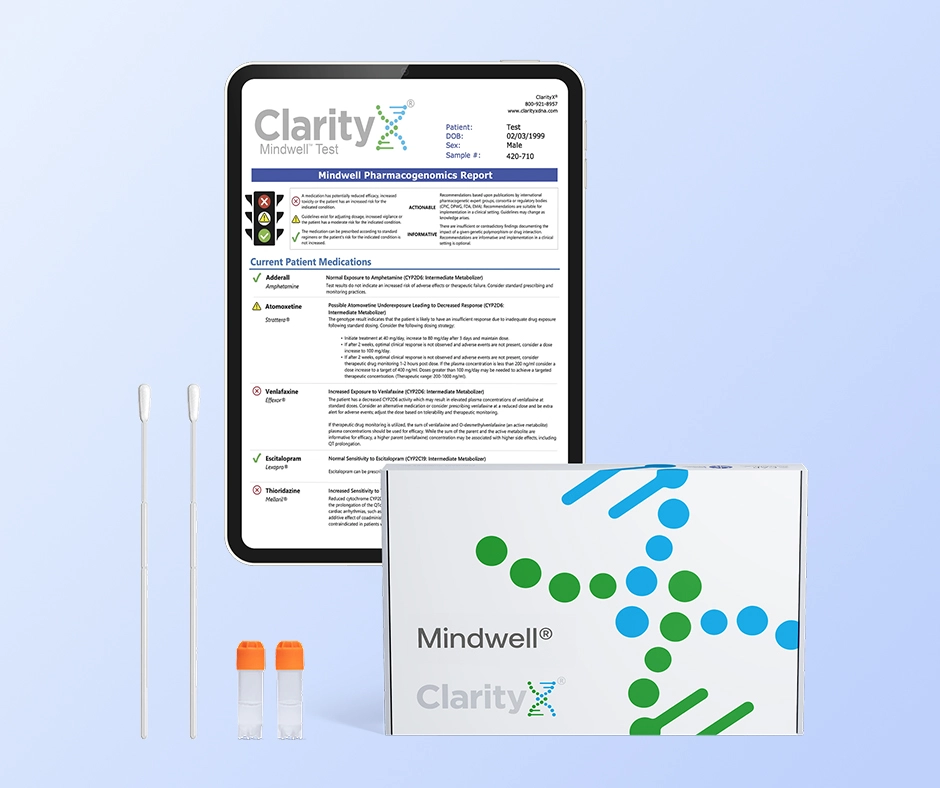Introduction:
In today's fast-paced world, mental health has become an increasingly important topic of discussion. As the prevalence of mental health disorders continues to rise, so does the need for effective treatment options. Antidepressant medications have proven to be valuable tools in managing conditions such as depression, anxiety disorders, and obsessive-compulsive disorder. Two commonly prescribed antidepressants, fluvoxamine and Prozac, have gained recognition for their efficacy in treating these conditions. However, understanding the differences between these medications is crucial for patients and healthcare providers alike.
In this article, we’ll look at fluvoxamine and Prozac, exploring their mechanisms of action, approved uses, side effects, and more. By shedding light on the distinctions between these two medications, we aim to empower individuals to make informed decisions about their mental health treatment options. Whether you're a patient searching for the most suitable medication or a curious reader seeking to enhance your knowledge, join us on this journey as we explore the differences between Fluvoxamine and Prozac.
Background on Fluvoxamine
Definition and classification of Fluvoxamine
Fluvoxamine, or Luvox, belongs to the class of drugs known as selective serotonin reuptake inhibitors (SSRIs). SSRIs are a type of antidepressant medication, and they work by increasing the amount of serotonin, a neurotransmitter, in the brain.
Mechanism of action
SSRIs like fluvoxamine work by blocking the reuptake of serotonin into the presynaptic cell, increasing the amount of serotonin that is available. This may improve symptoms of depression and anxiety. Fluvoxamine is absorbed well from the gastrointestinal tract and reaches peak concentrations in about 2 to 8 hours. It is extensively metabolized by the liver, primarily by the CYP1A2 and CYP2C19 enzymes of the cytochrome P450 system, with a half-life of about 15 to 20 hours. Half-life refers to how quickly the medication is removed from the body. CYP1A2 and CYP2C19 vary greatly between individuals.
Approved uses and indications
Fluvoxamine is FDA-approved for the treatment of obsessive-compulsive disorder (OCD) in both adults and children. It is also used off-label (meaning the FDA has not approved this use) for conditions like social anxiety disorder, panic disorder, and major depressive disorder.
Fluvoxamine has shown potential as a treatment for COVID-19 in several studies. It appears to help prevent clinical deterioration in patients, reducing the need for hospitalization and alleviating symptoms. It works by potentially altering cell processes and signaling. However, while the results are promising, more large-scale, randomized, controlled trials are needed to confirm fluvoxamine's effectiveness against COVID-19.
Common side effects
Common side effects of fluvoxamine include nausea, vomiting, drowsiness, dry mouth, loss of appetite, sweating, and trouble sleeping. In rare cases, it can lead to more serious side effects such as serotonin syndrome, a potentially life-threatening condition that can cause symptoms like agitation, hallucinations, rapid heartbeat, fever, muscle stiffness or twitching, and loss of coordination.
Background on Prozac
Definition and classification of Prozac
Prozac, or fluoxetine, is also an SSRI that enhances serotonin levels, a neurotransmitter, within the brain.
Mechanism of action
Prozac, like fluvoxamine, functions by blocking the reuptake of serotonin into the presynaptic cell. This action increases the concentration of serotonin in the body. Fluoxetine is also absorbed well from the gastrointestinal tract, but it takes longer to reach peak plasma concentrations (6-8 hours). It is metabolized in the liver primarily by the CYP2D6 enzyme of the cytochrome P450 system. Fluoxetine and its active metabolite, norfluoxetine, possess considerably longer half-lives compared to fluvoxamine, ranging from 2 to 4 days and 7 to 15 days, respectively. This prolonged duration indicates that they remain in the body for an extended period of time.
Approved uses and indications
Fluoxetine is FDA-approved for:
-Adults
-Bipolar I Disorder depression – only adjunct (add-in) usage
-Bulimia nervosa
-Obsessive-compulsive disorder (OCD)
-Panic disorder
-Premenstrual dysphoric disorder (PMDD)
-Off-label – anxiety, cataplexy, neuropathic pain, post-traumatic stress disorder (PTSD)
-Pediatrics
-Bipolar I disorder (acute depression) – 6-17 years old
-Major depressive disorder (MDD) – 7-17 years old
-Obsessive-compulsive disorder (OCD) – 10-17 years old
-Off-label – bulimia nervosa, cataplexy, insomnia, post-traumatic stress disorder (PTSD), and social anxiety disorder (SAD)
Fluoxetine has also demonstrated potential as a therapeutic option for COVID-19. Studies suggest that it may reduce mortality rates among hospitalized patients and could be effective even in the later stages of the disease. The drug's anti-inflammatory properties and its ability to improve a patient's mood during hospitalization are thought to contribute to these positive outcomes. However, while these findings are encouraging, they are based on limited data and further large-scale, randomized, controlled trials are required to definitively establish fluoxetine's role in COVID-19 treatment.
Common side effects
Common side effects of fluoxetine include nausea, upset stomach, diarrhea, dry mouth, sleep problems, sweating, and weight changes. On rare occasions, it is possible for more severe adverse effects to arise, including serotonin syndrome. This condition is potentially life-threatening and is marked by symptoms such as agitation, hallucinations, rapid heartbeat, fever, muscle stiffness or twitching, and impaired coordination.
Efficacy and Effectiveness
Clinical studies and research comparing Fluvoxamine and Prozac
- A study with 100 outpatients diagnosed with major depressive disorder compared fluvoxamine and fluoxetine. Both medications showed similar effectiveness in reducing depressive symptoms, with a 60% improvement in scores over a 7-week trial. There were no significant differences between the two drugs in terms of how well they worked. Side effects were generally tolerable, with only a few patients discontinuing due to them. However, fluvoxamine caused less nausea compared to fluoxetine. In conclusion, both medications were found to be effective in reducing depression, but fluvoxamine had fewer cases of nausea.
- A study involving patients with major depression, two medications, fluvoxamine and fluoxetine, were compared. The study randomly assigned 184 patients to either take fluvoxamine (100 mg/day) or fluoxetine (20 mg/day) for 6 weeks. The results showed that both medications were effective in treating depression, and there were no significant differences between them in terms of the overall improvement in depression scores.
Both medications were generally well tolerated, and there were no major differences in their side effects. Overall, the study concluded that fluvoxamine and fluoxetine have similar effectiveness and safety profiles for treating major depression. However, fluvoxamine may act more quickly in relieving depressive symptoms and lead to better improvement in sleep quality compared to fluoxetine.
Effectiveness in treating various conditions (e.g., depression, anxiety disorders, obsessive-compulsive disorder)
Fluoxetine (Prozac)
- Fluoxetine has an average rating of 7.3 out of 10 from a total of 374 reviews for the treatment of Anxiety and Stress.
- 67% of reviewers reported a positive experience, while 19% reported a negative experience.
- Generally effective in treating anxiety and stress, but individual experiences can vary significantly.
Fluvoxamine (Luvox)
- Fluvoxamine has an average rating of 5.3 out of 10 from a total of 78 reviews for the treatment of Anxiety and Stress.
- 40% of reviewers reported a positive experience, while 60% reported a negative or neutral experience.
- Effective in treating anxiety and stress but can vary significantly between individuals.
Prozac received a better overall user rating than fluvoxamine of 7.3/10 for 2127 review. Users only rated fluvoxamine as 6.7/10 for 360 reviews. Users reported positive effects from the medication 65% of the time for fluoxetine reviewers and only 55% of fluvoxamine.
Comparative analysis of efficacy and response rates
Fluvoxamine and Prozac have similar overall efficacy in treating major depressive disorder. However, there are a few differences that might influence the choice of treatment depending on individual patient characteristics and the specific disorder being treated.
Studies show fluvoxamine and Prozac were found to be effective in treating major depressive episodes, with no statistically significant differences in the overall change from baseline. However, fluvoxamine may have a faster onset of action with respect to the resolution of depressive symptoms and resulted in better improvement in sleep quality during the last 2 weeks of treatment.
Both fluoxetine and fluvoxamine have shown potential benefits in the treatment of COVID-19, with several studies suggesting a reduction in hospitalizations, symptom severity, and mortality rates. However, more large-scale, randomized, controlled trials are needed to confirm these findings.
Safety and Side Effects
Comparison of common side effects
Fluoxetine and fluvoxamine can have side effects typical of SSRIs. Common side effects for SSRIs, which include asthenia, diarrhea, dizziness, drowsiness, dyspepsia, insomnia, nausea, nervousness, constipation, headache, anorexia, and xerostomia. Prozac has been reported to be more likely to cause insomnia than drowsiness. If weight is a concern, Prozac is more commonly associated with weight loss than gain. Nervousness, activation, and anxiety are more likely to occur with Prozac than fluvoxamine. Fluvoxamine is more likely to cause drowsiness.
Withdrawal symptoms can occur if the medication is stopped suddenly. Fluoxetine tends to have milder withdrawal symptoms due to its longer half-life. On the other hand, fluvoxamine may cause more noticeable withdrawal symptoms if abruptly discontinued. Gradually reducing the dose of fluvoxamine under the guidance of a healthcare provider is usually recommended to minimize withdrawal symptoms.
Rare but severe side effects and warnings
Fluvoxamine and fluoxetine, both being SSRIs, share many of the same potential side effects and warnings. While most people who take these medications experience only mild side effects, there are some rare but serious side effects and warnings that you should be aware of:
Both
- Abnormal Bleeding: SSRIs and SNRIs may increase the risk of bleeding events. Concomitant use of aspirin, nonsteroidal anti-inflammatory drugs (NSAIDs), warfarin, and other anticoagulants may add to this risk.
- Hyponatremia: Low levels of sodium in the blood can occur, potentially leading to seizures, coma, respiratory arrest, or death.
- Serotonin Syndrome: This is a potentially life-threatening condition that can occur with the use of serotonergic drugs. Symptoms may include agitation, hallucinations, rapid heartbeat, fever, excessive sweating, shivering, or shaking, muscle twitching or stiffness, loss of coordination, nausea, vomiting, or diarrhea.
- Suicidal Thoughts and Behaviors: Antidepressants increased the risk of suicidal thoughts and behavior in pediatric and young adult patients in short-term studies. Monitor for clinical worsening and emergence of suicidal thoughts and behaviors.
Fluvoxamine
- Angle-Closure Glaucoma: Angle-closure glaucoma has occurred in patients with untreated anatomically narrow angles treated with antidepressants.
Fluoxetine
- Allergic Reactions and Rash: Severe allergic reactions are rare but can occur. In some cases, a rash can be a sign of a serious condition, such as Stevens-Johnson syndrome or toxic epidermal necrolysis.
- QT Prolongation and Ventricular Arrhythmia including Torsade’s de Pointes: These are rare heart conditions that can be potentially life-threatening.
Interactions with other medications
Examples of medications to avoid:
Both
- Monoamine Oxidase Inhibitors (MAOIs): Serious, sometimes fatal reactions occur when SSRIs and SNRIs, like fluvoxamine, are taken with an MAOI or within 14 days of stopping an MAOI.
- Other SSRIs or SNRIs: Combining with other drugs that affect serotonin levels can increase the risk of serotonin syndrome. This includes other SSRIs (like paroxetine, sertraline), SNRIs (like venlafaxine, duloxetine), and a variety of other types of drugs.
- Pimozide, Thioridazine: These antipsychotic medications can interact to cause serious heart rhythm problems.
Fluvoxamine
- Benzodiazepines – ex alprazolam, diazepam, lorazepam
- Carbamazepine, clozapine – fluvoxamine may elevate levels of these.
- Omeprazole
- Propranolol
- Theophylline
- Tizanidine
- Triptans (migraine medications): Drugs like sumatriptan and zolmitriptan can have their effects increased by fluvoxamine, potentially leading to serotonin syndrome.
- Warfarin: Fluvoxamine can increase the effects of warfarin, leading to an increased risk of bleeding.
Fluoxetine
- QT prolonging agents
- Tamoxifen: Fluoxetine can make this breast cancer medication less effective.
- Tricyclic antidepressants (TCAs)
- Tryptophan, St. John's Wort, and other over-the-counter supplements: These can interact with fluoxetine to increase the risk of serotonin syndrome.
These lists are not exhaustive. Always discuss your current medications, including over-the counter meds, with your healthcare provider and pharmacist before starting any new medication.
Conclusion
Fluvoxamine and fluoxetine, both SSRIs, are effective treatments for conditions such as depression, anxiety disorders, and obsessive-compulsive disorder. Some evidence suggests fluvoxamine may have a faster onset of action and result in a better improvement in sleep quality. However, individual patient experiences and side effect profiles can vary. Since fluvoxamine and Prozac are processed by the liver differently, pharmacogenomic (PGx) testing can provide valuable insights into which would work better in you. Knowing your unique genetic makeup can optimize therapeutic response and minimize adverse effects.
Looking for help determining the best medication options for your specific health concern? See how ClarityX can help!
Compare medications reported in ClarityX
Resources used:
- A comparison of fluvoxamine, fluoxetine, sertraline and paroxetine examined by observational cohort studies - PubMed (nih.gov)
- Comparative efficacy and acceptability of 21 antidepressant drugs for the acute treatment of adults with major depressive disorder: a systematic review and network meta-analysis (thelancet.com)
- https://online.epocrates.com/drugs/1153/fluoxetine
- https://online.epocrates.com/drugs/923/fluvoxamine
- https://pubmed.ncbi.nlm.nih.gov/12858325/
- https://pubmed.ncbi.nlm.nih.gov/8889909/
- https://www.drugs.com/comments/fluoxetine/prozac-for-anxiety-stress.html
- https://www.drugs.com/comments/fluvoxamine/for-anxiety-stress.html
- https://www.drugs.com/compare/fluoxetine-vs-fluvoxamine
- https://www.mdpi.com/1422-0067/23/7/3812





